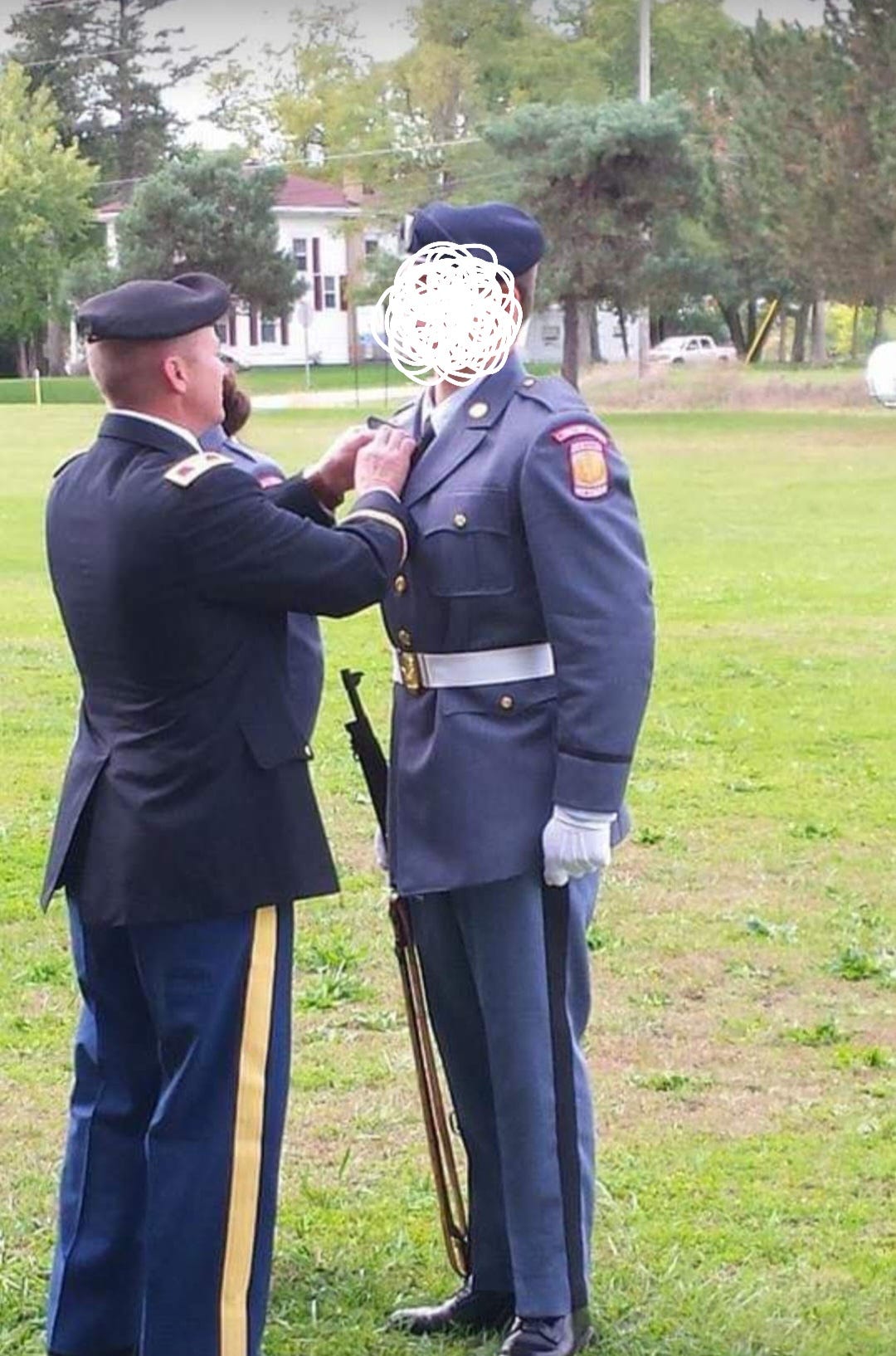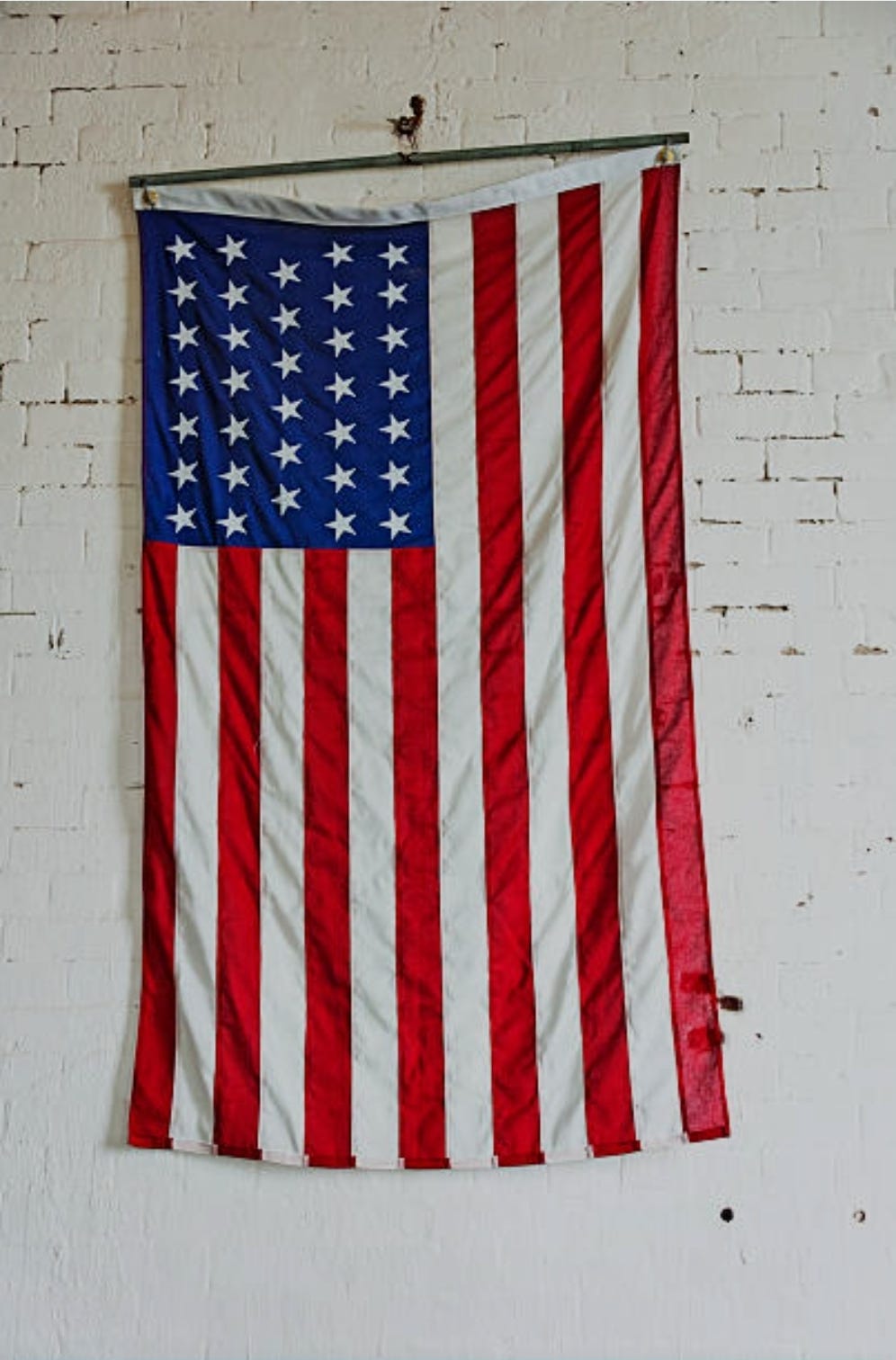Confession #14: We Are Not the Home of the Free
With Liberty and Justice For Some
My youngest son currently attends an American charter school. Every morning, all of the students stand together to say the Pledge of Allegiance as a group.
Yes, that is still a thing.
Parents are allowed to attend the Flag ceremony and announcements at drop-off, so I am frequently there as a gymnasium full of kids say, in that old and familiar sing-song unison, “One Nation— Under God— Indivisible— With Liberty and Justice for All.”
I place my own hand over my heart and go along but every time I say it, I cringe at the end. The “For All” part is bullshit. My oldest son woke up in a prison cell this morning again because, well, addiction.
I will not suffer ideological bickering.
The Pledge is, like it or not, a part of American history. Francis Bellamy, the author of the Pledge, was an editor and clergyman from the state of New York who, by all accounts, was a servant and a generous citizen. Though it may come as a surprise to our modern understanding, he was a [self-proclaimed] democratic socialist. He also spoke in favor of, and deeply believed in, American individualism. Shocker— people can think independently and hold varied beliefs.
It was the National Education Association (NEA) who took his pledge and added a flag raising to the recitation, installing this into the daily practice of our American public school curriculum. Over 140 years later, my 6-year-old is still engaged in that tradition while my 27-year-old sits in a cell as part of an American mass-incarceration experiment.
Weird times.
As a child, my now incarcerated son had no greater ambition than to enlist and serve in the American military. I have photo albums full of his homemade uniforms and make-believe battlefields. He was obsessed with little green Army guys long after it was “cool” for his age. He was always saluting— standing along the route of Memorial Day and 4th of July parades with a reverence beyond his age and understanding.
As a teen, he attended military academy (after being expelled from public high school), where he quickly assimilated to the rigor and routine. He joined the ROTC Cadets who voluntarily carried an extra 50 pounds in their backpacks all day, running as a unit from building to building, completing 50 pushups before entering the mess hall 3 times a day.
We all believed that his life would lead to risk-taking— albeit the kind that is applauded.
He has told me, from his prison cell, that the darkest part of his addiction journey began after he realized that his early legal troubles would prevent him from enlisting and living out his life-long dream of becoming an Airborne Ranger. He had lost his honor (those are his words), and the ensuing shame spiral eventually led to where we are today.
His idea of honor, in hindsight, was distinctly American and, I fear, a tad misinformed. American boys learn American ways— for better and for worse. My boy had grown up with a cinematically-informed idea that he could only be truly virtuous if he was issued a gun and commissioned to go fight for something.
His nickname at military academy was Rambo.
Rambo— as in John Rambo— the fictional Green Beret who, as a veteran, experienced trouble with local law enforcement after coming home from war. John Rambo was arrested for looking a certain way, and as the story intensifies, he is pushed further into isolation and misunderstanding until he is screaming and blowing things up and killing people.
While my son never physically harmed anyone but himself, his path led to prison instead of the military. Instead of jumping from airplanes on behalf of the U.S. Army, he is obeying correction officer commands at dawn. Instead of climbing rank to retire, he is working to level down.
Ironically, he is told when to wake, where to stand, what to eat, and what to do every hour of his day. He sleeps in a bunk. He wears an instantly recognizable blue ‘uniform.’ He is subjected to regular ‘room’ inspections. And, sadly, he has been trained to suppress any outward reaction to the violence and trauma in his environment. Eventually, he will face re-entry challenges when his time there is done.
A friend of mine’s son was recently commissioned a pilot in the United States Air Force. During one of our conversations about our kids, I realized that our fears— though worlds apart— were the same. As moms of adult children, we are all just holding our breath.
I had the opportunity this month to meet up with a local farmer to discuss some plants and other local farm things. He was a kind-faced and intentional man, withered by age and weather. As we spoke, our conversation meandered into the abysmal state of institutional food— he an advocate for local school lunch programs and me, an advocate for improving access to nutrition in prisons.
When I admitted my heart for prison reform, he stopped and cocked his head to the side. “Funny you should mention prison—” he started.
Turns out, he had just hired two women who will be returning to the community post-incarceration in a few weeks. Though he has historically hired university interns, he is now employing returning citizens. He softly alluded to his time in Vietnam and admitted to a shared sense of alienation from society. His empathy was palpable, and he didn’t need to say anything more.
One in three of our 19 million U.S. veterans have been arrested at least once.1 American jails and prisons currently hold over 180,000 veterans.2 At last count, 300 U.S. veterans are sitting on Death Row.3
I am not poised to debate whether it is a (big T) trauma chicken or they were incubated as a trauma egg. It matters not because in our society, we treat neither with care nor consideration. We do not typically train our young men to recognize and address their strong emotions nor manage difficult life events with vulnerability and social support— until they have crossed big lines. Until crisis hits, we expect them to grow some balls, don't act like a bitch, man-up, suck it up, rub some dirt on it, and hit him back.
The average age of military enlistment is 19.3 years old.4 The average age of first arrest for those in state prison is 19 years old.5 The vast majority of individuals in these American institutions are male— almost 90%, respectively.
There is not enough time nor data space here to discuss all of the potential reasons that this demographic seeks risk-taking for honor or to their detriment (or both), but the statistics on their poor mental health and addiction outcomes are not a coincidence. One quarter of our young men are clinically lonely.6 They account for 75% of American suicides and 75% of American substance use disorder diagnoses.7
Young American men make uninformed decisions that impact the rest of their lives every day. For some, it is an honorable and fulfilling road. For others, it is their undoing.
Our State Supreme Court recently ruled it unconstitutional to sentence individuals aged 19-20 to mandatory life in prison. They cited brain science studies which indicate that young adult brains are more neurologically similar to adolescent brains than to adult ones.
One of our local politicians shared her disdain for this Supreme Court decision on Facebook with a Canva-created, red-white-and-blue bordered graphic. It read, “The idea that 19 and 20-year-olds are somehow incapable of understanding right from wrong is insulting to victims and their families, and our justice system.” Her finger pointing stance on the Senate floor is prominent in half of the post. She is a prominent woman.
Amidst the thumbs up emojis and “FACTS!” and “Thank You!” and “God Bless you Senator!” comments, I typed:
“Respectfully, we do not allow our citizens under the age of 21 to buy alcohol nor own a handgun nor rent a car for a reason. Your statement ignores neuroscience and the biological reality of brain development. As a mom, I completely disagree with you.”
The online rebuttal was swift, “So why are they ‘aloud’ in the military then?” One commenter responded. Grammar and all, I offered him grace—
“Oh, sir. There may be a psychological reason that our governments specifically target young people to sign up for the job of war. The better inquiry is to ask how many of our young people return from these ‘choices’ with permanent mental health issues. As a psychologist, I have met too many to count.”
He did not respond.
My question, however, is not rhetorical.
It is not my intention to hijack a day of national memorialization for those men and women who have given the ultimate sacrifice for their country. I have a flag on my front porch year round, and my grandfather was a proud American Marine. Memorial Day is sacred and solemn and should not be muted by political screeching.
And— in case it needs to be said, I am not advocating an abolition of accountability.
There are dangerous individuals, some of them veterans, who have caused irreparable harm to our communities. Veterans are more likely than non-veterans to be incarcerated for violent offenses— homicide, sexual assault, and weapons-related charges. However, of our incarcerated veterans, more than a quarter of them have endured combat exposure resulting in serious mental health diagnoses and/or TBI. There are roughly 17 veteran suicides per day— mostly men, and mostly by firearm, in this Land of the Free.8
Maybe we pause this weekend to recognize that our loss of service members extends beyond those fallen in battle— some have life sentences, some are locked in isolation cells in mental anguish, and far too many have ended their own lives already in the belief that they are irredeemable. Might I suggest a separate day of remembrance for those soldiers who did not mentally return home?
We can skip the boats and noodle salad for that one.
If you know a veteran who has been impacted by incarceration— or someone working to change these sad statistics— I would love to hear from you in the comments or via DM.
https://www.upi.com/Top_News/US/2022/08/23/one-in-three-miltary-veteran-report-being-arrested/7131661299567
https://counciloncj.foleon.com/veterans-commission/reflections/
https://deathpenaltyinfo.org/research/analysis/reports/in-depth/battle-scars-military-veterans-and-the-death-penalty
https://www.cna.org/pop-rep/2000/html/chapter2/c2_age.htm
https://www.prisonpolicy.org/reports/beyondthecount.html
https://www.washingtonpost.com/nation/2025/05/21/lonely-young-american-men-poll/
https://pmc.ncbi.nlm.nih.gov/articles/PMC6109884/
https://stopsoldiersuicide.org/vet-stats






Your ability to write so clearly and well, while holding so much weight and heaviness, is incredible, Bridget. Thank you for sharing as you do. I’ll be remembering all of this this wknd. And you.
I teach Sociology—this sits at an interesting intersection of the concept of total institutions (Goffman) and gender. A piece I will consider sharing with my students. Excellent framing and writing.